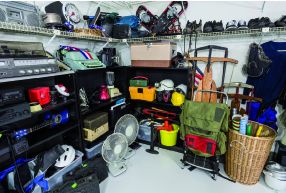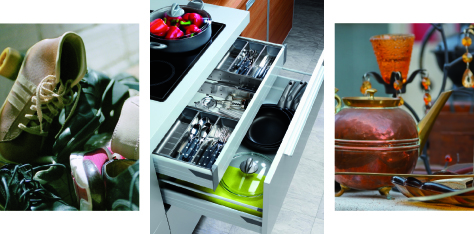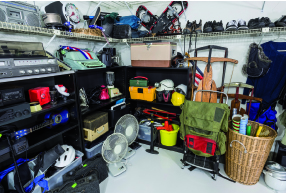Out with the Old: Toss the Clutter and Love What Remains


Your house probably doesn’t look like an episode of Hoarders. Maybe it’s just uncomfortably full, the way your belly feels after Thanksgiving dinner. You may be moving or down-sizing, or your style may be evolving. Or perhaps you’ve embraced the latest trend in minimalism where less is more and doing without is a somewhat demented medal of domestic honor (a medal that you’d have been happier to earn if the new trend hadn’t come on the heels of last year’s Pinterest craze). Regardless of the reason, we all could stand to get rid of some stuff.
Too much unwanted stuff weighs on us mentally and emotionally. The less “stuff” we have, the less we have to clean and organize, the less stress we feel and the happier we are. It’s hard to get rid of that stuff though. We tend to get attached to our things, even things we don’t use or especially like. We are sentimental about the buffet that Aunt Mitzi gave us before she moved to assisted living. We are still waiting for someone, anyone, to play that secondhand piano we gladly inherited with visions of warm evenings, tinkling keys and laughter. But there it sits, a perch for mail and knickknacks. We hold onto items that bring back memories, like the lamp we received as newlyweds and threw during our first argument (and then lovingly glued back together).
We have trouble parting with these items because we’ve personalized them, made them too much a part of the fabric of our story. But memories aren’t best honored with objects that no longer bring you joy. This is not a call to rid your house of all emotional valuables, but…letting go is freeing, and if you’re moving or downsizing, it’s downright necessary.
 So here are some things to consider and tips for holding on to your memories without holding on to your stuff:
So here are some things to consider and tips for holding on to your memories without holding on to your stuff:
1. Go room by room beginning with the smallest: visualize the bare bones of the room, those elements that make it a livable, pleasing space. What are the most essential pieces of furniture? What does not belong? Piece by piece ask yourself: Do I love this? Is it useful? If you answer no to either question, it may be time to get rid of it.
2. Do you have any clutter-capturing furniture, for example a chair in your bedroom that is never sat on but instead houses discarded clothing? Consider finding it a new home.
3. Does each piece of furniture in your home resonate with your current sense of style? Are there pieces that get in your way? Would you buy it again, today?
4. Evaluate your artwork. Bare walls can be clean and refreshing. If you don’t love it, someone else might.
5. Carry a box or laundry basket around your house and fill it with household items that are creating clutter.
6. Do you have a big clunky piece of furniture housing your television? Consider hanging a flat-screen on your wall instead.
7. Set a goal of purging one large item per day. Or, if you are really serious, one item per room per day.
8. Why are you keeping it? Attach your emotions to the memory, not the thing. Take pictures of items you want to remember but no longer use.
 Now that you’ve selected items to purge, what do you do with them? Furniture and household items that are merely sentimental to you may be useful to someone else. Additionally, purging yourself of items you no longer need, use or love may present an opportunity to make some extra cash before the holiday season, as several local businesses stand ready and willing to take that stuff off your hands and sell it for you. These anti-clutter angels are called consignment stores.
Now that you’ve selected items to purge, what do you do with them? Furniture and household items that are merely sentimental to you may be useful to someone else. Additionally, purging yourself of items you no longer need, use or love may present an opportunity to make some extra cash before the holiday season, as several local businesses stand ready and willing to take that stuff off your hands and sell it for you. These anti-clutter angels are called consignment stores.
The word consignment comes from the French word consigner, meaning “to take from your home all of the stuff you don’t want and bring it to a clever storekeeper who will sell it for you, giving you cash and/or the opportunity to purchase fabulous items that someone else didn’t want.” At least that is the working definition! The real definition is “to hand over or transmit.” A “consignment shop” is a second-hand shop that sells used items for owners (consignors), typically at a lower cost than the items would fetch if new. The consignee (the seller) pays the consignor (that’s you) a portion of the proceeds when the item sells.
 There are several consignment shops in our area that will accept new and gently used items that are clean, free of dust, stains and odor and that are in good condition. As professionals, they are uniquely suited to work with you on a price that will move the item quickly. Always call the store and ask whether it accepts furniture and household items and whether you need an appointment to bring in your items. Next Time Consignment on Waterlick Road in Forest suggests emailing or bringing in a picture of larger items. Owner Bonnie Hager says that bar stools, chests, night stands, beds and unique housewares are among her best-selling items.
There are several consignment shops in our area that will accept new and gently used items that are clean, free of dust, stains and odor and that are in good condition. As professionals, they are uniquely suited to work with you on a price that will move the item quickly. Always call the store and ask whether it accepts furniture and household items and whether you need an appointment to bring in your items. Next Time Consignment on Waterlick Road in Forest suggests emailing or bringing in a picture of larger items. Owner Bonnie Hager says that bar stools, chests, night stands, beds and unique housewares are among her best-selling items.
The rules of consignment may differ among shops, but generally, the shop will display your item for a certain amount of time, usually 90 days, and may offer a discount at some point. When the item sells, the consignee will pay you a percentage of the selling price. Usually, if an item does not sell within 90 days, most stores will allow you to retrieve it or they will donate it for you.
Remember, if it’s not useful or beautiful, then the memory you’ve linked to an object might be better served by becoming just that: a memory. Aunt Mitzi may have preferred you create a stress-free beautiful home rather than hold onto that old buffet. And who knows? There might be someone out there who has a buffet-sized hole in her living room that could be filled by a piece from your past. Feel free to pass it on!
When You Have an Extraordinary Item Working with Auction Houses, Estate Liquidators and Specialty Retailers
If you have an antique, artwork, or a collection to sell, consider calling a professional liquidator. Auction houses, estate liquidators and even some high-end specialty retail stores will often agree to consign furniture on your behalf or even purchase it outright from you for resale in their shops.
Not only is using a professional much safer than listing an item on the Internet and having strangers visit your home, an auction house or estate seller will ensure that your items are viewed by the appropriate audiences—serious buyers who are willing to pay what your item is worth.
Typically, you’ll request an appointment, and they’ll come to your home to inspect your items and make you an offer. Once a formal agreement has been made, they’ll transport your items to the site of the sale.
You may find that you have to negotiate with the buyer for the price on your piece of furniture. You can make a counteroffer if the buyer’s offer seems too low. After all, haggling is part of this process. Decide ahead of time how firm you are going to be on your price.
Before you make that phone call, do your homework and determine the value of your item. Is it in good condition? Is it an antique or did a famous manufacturer make it? If not an antique, how much did you pay for it when you bought it?
Take lots of photographs and provide as much documentation about your piece as possible.
The Price is Right
Be realistic when pricing your furniture. Ideally, your item should be free from dents, stains or scratches. Make any necessary repairs. A buyer will happily pay a better price for a quality piece that is in good condition.Size Matters
It is easier to sell smaller pieces of furniture because they are easily transported and fit into most homes. Your customer might have to incur additional costs when taking oversized furniture home, so take that into account when pricing larger items.Items in a neutral style might be better than a something that is more specialized because simple styles can find a home in any style interior. Unusual or custom-made items might prove hard to sell.
Retro and mid-century modern furniture is very popular and usually can command a higher selling price.
Upholstered goods are the hardest to sell. You’ll have better luck with cased goods.
Working with a professional estate seller offers you peace of mind because having a contract keeps the process transparent, resulting in a sale that is fair and satisfactory to all.






